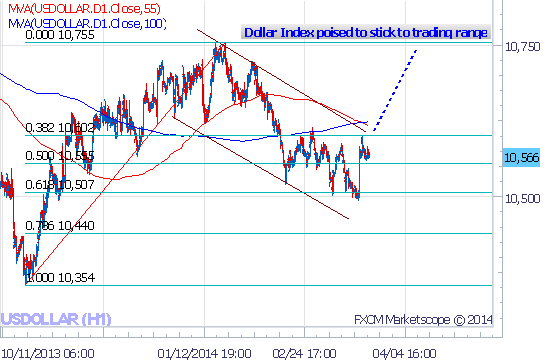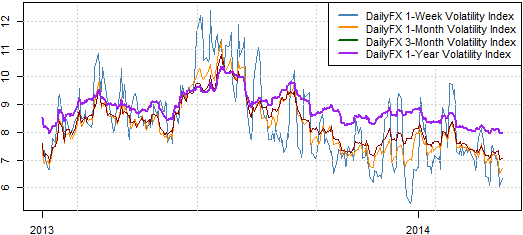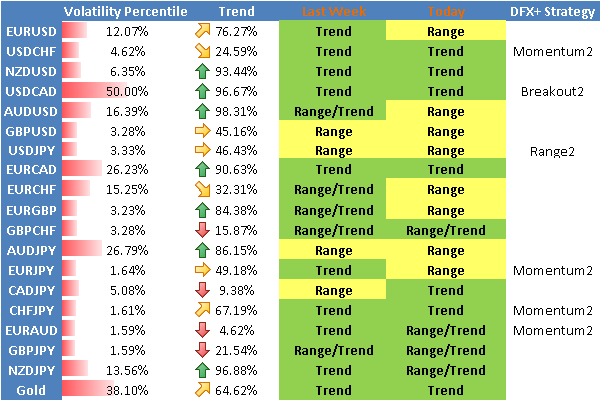US Dollar Unlikely to Break to Fresh Highs – Time to Sell?
- US Dollar surges, but we’re wary of buying at these levels
- Forex price and time cycles suggest end of week is critical for US currency
- Low FX volatility expectations make breakouts unlikely, selling USD near highs looks attractive
A significant reversal suggests that the US currency did indeed set an important and lasting low versus the Euro and other counterparts through last week’s trading. And yet the Dow Jones FXCM Dollar Index has stalled at key resistance immediately following its bounce off of support.
Dow Jones FXCM Dollar Index Stalls at Potentially Significant Price Ceiling

Source: FXCM Trading Station Desktop, Prepared by David Rodriguez
A sharp drop in forex volatility prices suggests that many expect the US currency to remain within a tight trading range. The end result is to leave us cautiously bearish the US Dollar through near-term trading.
Our Senior Strategist writes that an important confluence of Price and Time cycles favors a bigger pickup in price volatility towards the end of the week. In concrete terms this leaves us at somewhat of an impasse, but it may likewise be worthwhile to trade major pairs off of trading ranges as large breakouts seem unlikely.
Forex Volatility Prices Continue Trading near Lowest since Global Financial Crisis

Source: OTC FX Options Prices from Bloomberg; DailyFX Calculations
From an automated trading strategy perspective this leaves us largely to the sidelines. Discretionary traders may do well buying near range lows and selling near highs in pairs such as the Euro/US Dollar, British Pound/US Dollar, and other majors. Yet our primarily trend-following and volatility-friendly proprietary trading systems are less likely to outperform on extremely low market volatility.
This may all change of course if the Dollar reversal does indeed materialize heading into end-of-week trading. And if it does we’ll be sure to update our trading forecasts. Sign up for future e-mail updates via my distribution list.
DailyFX Individual Currency Pair Conditions and Trading Strategy Bias


Automate our SSI-based trading strategies via Mirror Trader free of charge
--- Written by David Rodriguez, Quantitative Strategist for DailyFX.com
To receive the Speculative Sentiment Index and other reports from this author via e-mail, sign up to David’s e-mail distribution list via this link.
Contact David via Twitter at http://www.twitter.com/DRodriguezFX
Definitions
Volatility Percentile – The higher the number, the more likely we are to see strong movements in price. This number tells us where current implied volatility levels stand in relation to the past 90 days of trading. We have found that implied volatilities tend to remain very high or very low for extended periods of time. As such, it is helpful to know where the current implied volatility level stands in relation to its medium-term range.
Trend – This indicator measures trend intensity by telling us where price stands in relation to its 90 trading-day range. A very low number tells us that price is currently at or near 90-day lows, while a higher number tells us that we are near the highs. A value at or near 50 percent tells us that we are at the middle of the currency pair’s 90-day range.
Range High – 90-day closing high.
Range Low – 90-day closing low.
Last – Current market price.
Bias – Based on the above criteria, we assign the more likely profitable strategy for any given currency pair. A highly volatile currency pair (Volatility Percentile very high) suggests that we should look to use Breakout strategies. More moderate volatility levels and strong Trend values make Momentum trades more attractive, while the lowest Vol Percentile and Trend indicator figures make Range Trading the more attractive strategy.
HYPOTHETICAL PERFORMANCE RESULTS HAVE MANY INHERENT LIMITATIONS, SOME OF WHICH ARE DESCRIBED BELOW. NO REPRESENTATION IS BEING MADE THAT ANY ACCOUNT WILL OR IS LIKELY TO ACHIEVE PROFITS OR LOSSES SIMILAR TO THOSE SHOWN. IN FACT, THERE ARE FREQUENTLY SHARP DIFFERENCES BETWEEN HYPOTHETICAL PERFORMANCE RESULTS AND THE ACTUAL RESULTS SUBSEQUENTLY ACHIEVED BY ANY PARTICULAR TRADING PROGRAM.
ONE OF THE LIMITATIONS OF HYPOTHETICAL PERFORMANCE RESULTS IS THAT THEY ARE GENERALLY PREPARED WITH THE BENEFIT OF HINDSIGHT. IN ADDITION, HYPOTHETICAL TRADING DOES NOT INVOLVE FINANCIAL RISK, AND NO HYPOTHETICAL TRADING RECORD CAN COMPLETELY ACCOUNT FOR THE IMPACT OF FINANCIAL RISK IN ACTUAL TRADING. FOR EXAMPLE, THE ABILITY TO WITHSTAND LOSSES OR TO ADHERE TO A PARTICULAR TRADING PROGRAM IN SPITE OF TRADING LOSSES IS MATERIAL POINTS WHICH CAN ALSO ADVERSELY AFFECT ACTUAL TRADING RESULTS. THERE ARE NUMEROUS OTHER FACTORS RELATED TO THE MARKETS IN GENERAL OR TO THE IMPLEMENTATION.
OF ANY SPECIFIC TRADING PROGRAM WHICH CANNOT BE FULLY ACCOUNTED FOR IN THE PREPARATION OF HYPOTHETICAL PERFORMANCE RESULTS AND ALL OF WHICH CAN ADVERSELY AFFECT ACTUAL TRADING RESULTS. Any opinions, news, research, analyses, prices, or other information contained on this website is provided as general market commentary, and does not constitute investment advice. The FXCM group will not accept liability for any loss or damage, including without limitation to, any loss of profit, which may arise directly or indirectly from use of or reliance contained in the trading signals, or in any accompanying chart analyses.
original source






 Indonesia
Indonesia